| Mount Vernon was the place George Washington called home. As
a child, he spent five years living there, from age three through
eight. As a teenager, anxious to enhance his social and professional
opportunities, young George moved to Mount Vernon to live with
Lawrence Washington, his older half brother. After his military
service, he returned to Mount Vernon and inherited it after
Lawrence's early death. In 1759, at the age of 27, George married
Martha Dandrige Custis, a widow. They settled at Mount Vernon with
his new bride and her two young children.
After two terms as
President, Washington returned to Mount Vernon for his final days.
Despite his 65 years, he embarked on many new projects, including a
successful distillery. On Dec. 14, 1799, the young nation was cast
into mourning at the dawn of a new century with the death of the
illustrious George Washington. Two hundred mourners came to Mount
Vernon to say good-bye to their leader.
The Mount Vernon property
was owned by the Washington family for seven generations-from 1674
when King Charles II granted the land to John Washington, George
Washington's great-grandfather, until 1858 when John A. Washington,
III, George's great-grandnephew, could no longer afford to keep
Mount Vernon running. To save the home of our first president, the
Mount Vernon Ladies' Association formed and purchased the home and
200 acres. Today, Mount Vernon welcomes over one million visitors a
year.
For more information, call
(703) 780-2000 or e-mail: mvinfo@mountvernon.org.
|
" I can
truly say I had rather be at home at Mount Vernon with a
friend or two about me, than to be attended at the seat of
government by the officiers of State and the representatives
of every power of Europe." -- George
Washington |
Come Take a
Tour
The
Mansion
When Washington inherited
the estate, the house consisted of four rooms, the central passage
on the first floor and three bedrooms on the second. The long
process of enlarging and improving the house began in the years
before his marriage, when Washington raised the Mansion from one and
a half stories to two and a half stories and extensively redecorated
the interior.
The house is constructed of
pine, but is rusticated, an exterior decorative treatment that gives
the appearance of stone. Washington himself designed the stunning
two-story piazza overlooking the Potomac River and the Maryland
shoreline. Here family and guests would gather in warm weather and
enjoy the breeze off the river. Washington also added the cupola
and, after the war, the beautiful "dove of peace"
weathervane.
Prior to the installation
of a modern drainage system around the foundation of the Mansion,
archaeologists excavated a trench four feet wide to record the
layers of soil and recover the artifacts. Thousands of small
artifacts (straight pins, buttons, broken ceramic and glass sherds,
fish bones, tobacco pipes) were swept out into the grass especially
near the doorways.
Excess moisture in the
Mansions basement was a concern for George Washington. A series of
brick drains installed about 1775 were part of an elaborate system
to channel water away from the house.
Large Dining
Room
 This two-story room is the largest in the house. Comprising
the entire north wing of the Mansion, it was a perfect area for
entertaining a large number of guests or for dancing. This two-story room is the largest in the house. Comprising
the entire north wing of the Mansion, it was a perfect area for
entertaining a large number of guests or for dancing.
Washington, ever practical,
did not place a dining room table in the room. Instead, boards were
placed on sawhorses, set with fine linen and china, and guests never
knew they were seated at a makeshift table. After dinner, the
temporary table could be easily cleared away to make room for
dancing or other entertainments.
Visitors to the room were
left with no doubt as to the General's interests. He personally
selected decorative plaster ornamentation of crops and tools that
reflected his love of farming. The stunning green color was also a
favorite of Washington's, and the design of the magnificent
Palladian window was adapted from a popular architectural book of
the day.
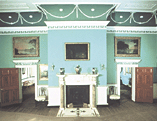 To complete the decor, Washington ordered two sideboards and
24 chairs from Philadelphia cabinetmaker John Aitken. The landscapes
and scenic paintings adorning the walls were chosen by Washington
and reflected his life-long love of nature and the
frontier. To complete the decor, Washington ordered two sideboards and
24 chairs from Philadelphia cabinetmaker John Aitken. The landscapes
and scenic paintings adorning the walls were chosen by Washington
and reflected his life-long love of nature and the
frontier.
The room was also the site
of significant beginnings and endings in American history. The
American presidency began here when, on April 14, 1789, Charles
Thompson, Secretary of Congress, informed George Washington that he
had been unanimously elected first president of the United States.
Ten years later a nation mourned while Washington's body lay here
for three days after his death on December 14, 1799, before being
buried in the family vault at Mount Vernon.
Little
Parlor
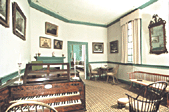 Music played an important part in the life of the Mount
Vernon household, as in the typical genteel Virginia home of the
period. The music master would travel from home to home, instructing
the young, and his presence often inspired lively social gatherings
at which music and dancing were the principal recreations. Although
Washington could not play an instrument, he did love music. He
purchased a spinet for his step-daughter Pasty Custis and a violin
and German flute for her brother Jacky. Years later, he purchased a
fine harpsichord and English guitar for his step-granddaughter,
Nelly Custis. Music played an important part in the life of the Mount
Vernon household, as in the typical genteel Virginia home of the
period. The music master would travel from home to home, instructing
the young, and his presence often inspired lively social gatherings
at which music and dancing were the principal recreations. Although
Washington could not play an instrument, he did love music. He
purchased a spinet for his step-daughter Pasty Custis and a violin
and German flute for her brother Jacky. Years later, he purchased a
fine harpsichord and English guitar for his step-granddaughter,
Nelly Custis.
Front
Parlor
Before the completion of
the large dining room, the west parlor, was considered by George
Washington to be "the best place in my house." The elegant room was
a public space, where guests to the home enjoyed the company of the
Washington family. As the principal parlor, this room received much
use. It was here that tea and coffee were customarily served during
the winter months and on rainy days, and where the family gathered
in the evenings to read and discuss the latest political
news.
The architectural elements
of this room make it one of the most interesting and finest
surviving examples of colonial Virginia architecture. The design of
the mantel was adapted from a popular 18th-century book, The British
Architect, by Abraham Swan. The mantel combined with the two
Palladian door frames and fully paneled walls, make the Front Parlor
one of the most architecturally significant rooms in the home. In
1787, changes were made to update the room, and the very fashionable
and expensive Prussian blue paint was used. The ceiling was also
replaced and decorated in the neo-classical style. Throughout the
room, one can find evidence of the Washington family, from the
family portraits that adorn the walls to the Washington family
coat-of-arms in the carved mantel and the family crest on the
decorative fireback.
Study
This room, part of the
south wing expansion begun in 1774 and completed in 1776, was
Washington's private sanctuary. Upon his return to Mount Vernon in
1783 at the end of the Revolutionary War, the study became the place
where he retired from ever-present family and guests to tend to
business without distraction. No one was allowed in without specific
invitation.
It was from this room that
he directed the management of his estate. He received the reports of
his overseers, made daily entries in his diary, and posted his
accounts.
Throughout the room
personal objects reflect the varying interests of Washington,
including an impressive library of 884 books. This room served not
only as an office, but also as a chamber where he bathed, dressed
and kept his clothes. Each day, he would rise between 4 am and 5 am
and go down to the study using the private staircase leading from
the master bedroom. If the weather was cold, he lit his own fire and
prepared for the day with little assistance from his body
servant.
He used the quiet time to
write letters or review reports until breakfast at 7am. He then
generally rode out to his farms. In the evening, unless he had a
social obligation, he would often return to his study to read or
confer with his secretary until he retired at about 9 pm.
Master
Bedroom
Located directly above the
study in the private south wing, it was the sanctuary of Mrs.
Washington and provided a quiet retreat from family and many guests.
Designed with suggestions from Mrs. Washington, the room is simple
with functional closets for the storage of linens and clothes. It
was here that she planned her schedule, wrote letters to friends and
family members, and kept careful watch over the operations of the
house and kitchen staff. According to her grandson, she also spent
an hour each day reading the Bible.
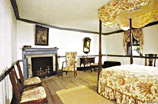 Portraits of her grandchildren adorn the walls, and it was in
this room that she assisted with their school lessons. A Chinese
lacquered dressing glass and a French mantle clock, purchased in
Philadelphia during the presidency and brought back to Mount Vernon,
provided elegant touches in the otherwise tasteful but simply
decorated room. Portraits of her grandchildren adorn the walls, and it was in
this room that she assisted with their school lessons. A Chinese
lacquered dressing glass and a French mantle clock, purchased in
Philadelphia during the presidency and brought back to Mount Vernon,
provided elegant touches in the otherwise tasteful but simply
decorated room.
Although this
room was associated most closely with Martha Washington, history has
tied it indelibly to George Washington. It was here that he died on
December 14, 1799 of a severe throat infection diagnosed by his
doctors as quinsy. Upon his death, Mrs. Washington closed the master
bedroom for the remainder of her life and retired to a room on the
third floor. It seems she did not wish to remain in a part of the
house that held so many memories of her life with George Washington,
her husband of 40 years.
|
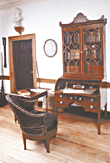 Secretary Secretary
This
neo-classical secretary and desk was at the forefront of new
furniture forms in the Federal period. Washington purchased
it, along with other furnishings, from John Aitken in
Philadelphia, at the end of his presidency. |
 Porcelain Porcelain
President Washington,
aware that the world was watching for signs that America's new
government would not last, took pains to see that official
furnishings reflected decorum and stability. He asked Governor
Morris to buy this fashionable pair of bisque porcelain
cherubs (possibly Niderville, c. 1789) for him in Paris, along
with a mirrored plateau on which they were
placed. |
| 0000 |
0000 |
| Burling Chair
Washington purchased
this "uncommon" chair from Thomas Burling in 1790. The
circular seat revolves on a central spindle with four rollers
made of bone. Thomas Jefferson admired it and had Burling make
one for Monticello.
 Mahogany side
chair Mahogany side
chair
Following
Washington's election to the presidency in 1789, Congress
acquired for his executive residence a large quantity of
furnishings, including this Chippendale style side chair, one
of 68 mahogany chairs purchased through Thomas Burling of New
York. One visitor described the rooms in the executive
residence as "furnished in the most elegant
manner."
Washington
letter
After her husband's
death, Martha Washington burned the letters they had written
to one another during their long marriage. Only two letters
survived, hidden behind the drawers in her desk. In this
short, autographed note, written as he was about to leave
Philadelphia to take command of the army at Boston (June 23,
1775), he reassured her: "I retain an unalterable affection
for you, which neither time or distance can
change."
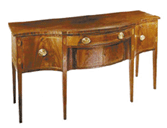 Federal Sideboard Federal Sideboard
Federal sideboard,
mahogany, tulip poplar and yellow pine, 1797. Along with the
24 chairs, Washington ordered from John Aitken of Philadelphia
two large sideboards for Mount Vernon's Large Dining Room.
They are in the Hepplewhite style. As with other furnishings
Washington selected, they are fashionable without
ostentation.
Harpsicord
Washington ordered
this double manual harpsichord with 61 notes from England for
Martha's grand-daughter, Nelly. It was shipped from London to
Philadelphia in 1793 and returned to Mount Vernon following
the presidency. Nelly's brother, Washy, recalled how his
sister would "play and cry and cry and play" as she practiced.
(See small parlor photo.) |
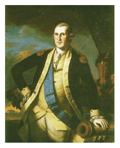 Washington
portrait Washington
portrait
Charles Willson Peale
painted this portrait in 1789 for Elias Boudinot, president of
the Continental Congress, and friend of George Washington.
Washington wears a blue ribbon indicating his rank as
Commander-in-Chief of the Continental Army. He is shown at
Princeton, New Jersey, where his January 1777 raid marked the
first time in open combat that American troops broke a British
line. He had ridden at the head of his troops, in direct fire,
seemingly invincible. Washington's stance and bearing express
an unshakable confidence in America's cause.
Kitchen
Midden
Before the garbage
man made weekly visits, trash was discarded about the yard.
George Washington's trash was thrown into shallow depressions
near the mansion. One of these was recently excavated and
yielded over 75,000 artifacts dating from the time before the
American Revolution. Ceramics, glass, toys, tobacco pipes, wig
curlers, scissors, oyster shells, animal bones, and crab claws
provide excellent information about the diet and daily life of
the Washington family.
Prior to the
installation of a modern drainage system around the foundation
of the Mansion, archaeologists excavated a trench four feet
wide to record the layers of soil and recover the artifacts.
Thousands of small artifacts (straight pins, buttons, broken
ceramic and glass sherds, fish bones, tobacco pipes) were
swept out into the grass especially near the
doorways.
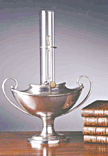 Argand Lamp Argand Lamp
Always interested in
technological advances, Pres. Washington ordered 14 new oil
lamps from France in 1790. It was reported that the lamps
(invented by Swiss chemist Aimé Argand and patented in England
in 1784), "consume their own smoke, do no injury to furniture,
give more light, and are cheaper than candles." The lamps were
later brought back to Mount Vernon.

|
|
His Famous Teeth
Washington's natural
courtesy and attention to detail did not fail him even when
dealing with painful false teeth. Contrary to popular myth,
his dentures were not made of wood. John Adams later commented
that Washington attributed the misfortune of his toothlessness
to "cracking of walnuts in his youth." Washington wrote to Dr.
John Greenwood in 1797: Sir: I must again resort to you for
assistance-The teeth herewith enclosed have, by degrees,
worked loose; and, at length, two or three of them have given
away altogether-I would thank you for returning them as soon
as possible for although I now make use of another set, they
are both uneasy in the mouth and bulge my lips out in such a
manner as to make them appear considerably
swelled."
|
|
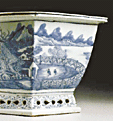 Chinese Flower Pot Chinese Flower Pot
The Washingtons first
bought blue and white Chinese porcelain in 1764. The patterns on
what Martha Washington called "...the blew and white china in common
[everyday] use" varied widely because additional purchases were made
thoughout Washington's lifetime. This hexagonal flower planter, c.
1775 features a landscape scene in blue underglaze. |
|
 Wedding Shoes Wedding Shoes
Few details are
known about the wedding ceremony of George Washington and Martha
Custis on Jan. 6, 1759. Martha wore a gold damask dress, trimmed in
lace.
According to
family tradition, she also wore these brightly-colored slippers
imported from England, c. 1758.
Covered in an
aubergine silk, the slippers are trimmed in metallic lace composed
of sequins and metal threads. They are lined with a combination of
kid leather, linen, and woven silk. |
|
 Surveyor's Compass Surveyor's Compass
At the age of 16,
Washington embarked on his first career as a surveryor of uncharted
western lands. One of the most important tools of the trade was a
compass that would typically be mounted on a Jacob's staff or tripod
in the field. Also known as a circumferentor, the magnetic compass
was used by Washington to determine a bearing on boundary
lines.
Surveying gave Washington a
job in which he was paid in cash rather than commodities. His
earnings enabled him to begin purchasing land, a practice he would
continue throughout his life. By the time he was 19, he owned
over 1,400 acres beyond the Blue Ridge Mountains. |
|
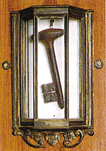 Bastille Key Bastille Key
In 1789, a Paris mob
sparked the French Revolution by storming the Bastille, a hated
political prison and symbol of absolute monarchy. The next year,
Lafayette ordered its demolition and sent an original key to the
Bastille to his former commander.
Washington displayed the
key and an accompanying drawing prominently in the Presidental
mansion and later at Mount
Vernon. |
|
Thanks to the
Mount Vernon Ladies Association for this article.
For more
information and pictures go to http://www.mountvernon.org/.
2002
|
|